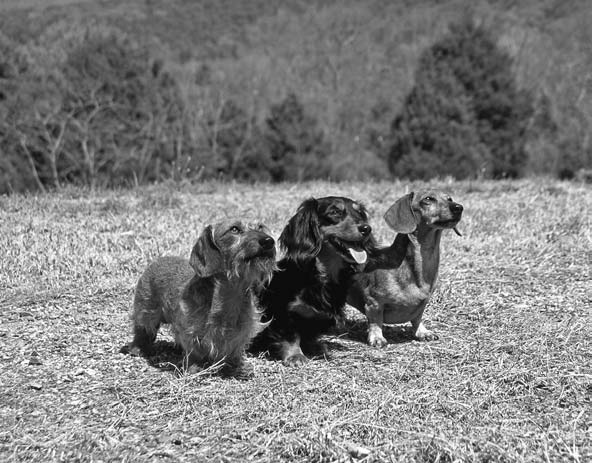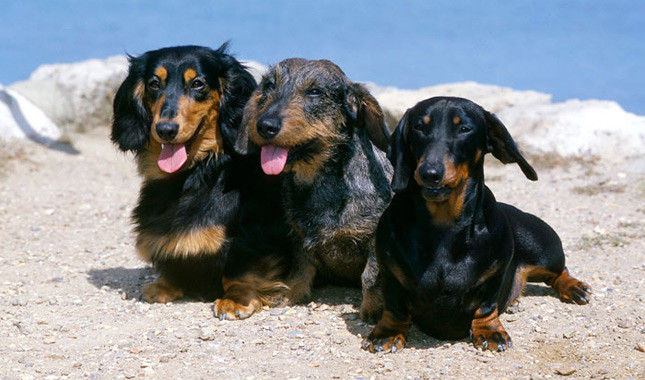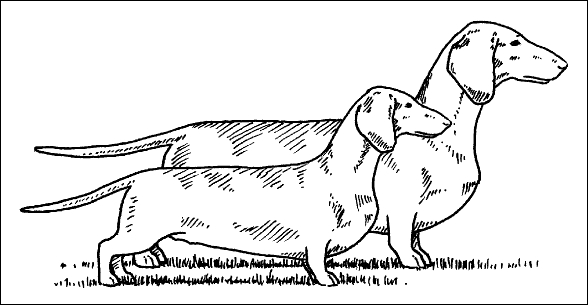- Deciding how much dog you need
- Picking out your favorite coat
- Settling on a color and pattern
- Choosing a boy or a girl (or boy and girl)
One of the great things about bringing home a Dachshund is that you have so many options: Big or small; longhaired, shorthaired, or wirehaired; and plenty of colors to choose from, too. Do you want a boy or a girl? A puppy or an older dog? You have some important choices ahead of you, and you need to think about some issues and weigh some options before you can choose the Dachsie that best suits your life. This chapter will help you consider your options. I also help shed some light on which Dachshund differences don’t really make any, well, difference, as well as those options that can make all the difference in the world.
Remember
The bottom line when choosing your new family member? All the cosmetic considerations don’t really matter that much (assuming you aren’t planning on breeding/showing your dog). Health and temperament, health and temperament, health and temperament are what matter. Make that your mantra as you visit breeders and meet puppies and their parents (see Chapter May the Best Breeder Win: Finding the Dachshund for You). The best dogs have two healthy parents — better yet, four healthy grandparents as well. They’re raised in a family home by a breeder who makes an effort to socialize them. They’re given proper medical care from the beginning of their lives and are bred to exhibit the classic Dachshund personality: fun, funny, feisty, fearless, and fantastic (see Chapter Defining the Dashing Dachshund). Need I say more?
Size Matters (Or Does It?)
Technical Stuff
By European standards, Dachshunds come in three sizes: Standard, Miniature, and Rabbit; the Rabbits, the smallest size, are approximately equivalent to a Miniature Dachshund, and sizes are distinguished by chest circumference rather than weight.
Determining your size match before you get the details
A. Energy, playfulness, and the Romp Factor.
B. The clowning, the hilarity of the big watchdog in a little package, and, of course, the Cute-as-a-Button Factor.
C. The combination of independent thinker and devoted companion.
A. Shedding — you can’t stand the thought of dog hair everywhere.
B. Barking — shrill noises really get to you.
C. Housetraining — yuck. There’s nothing worse than cleaning up a dog mess.
A. Kids under 5.
B. One other adult.
C. Another dog and/or a cat.
A. On a farm.
B. In an apartment.
C. In a house with a fenced backyard.
A. Pretty high. You like to go on walks, and you like to keep moving. You wonder, “Can Dachshunds catch a Frisbee?”
B. Pretty low. You’re housebound or can’t move too quickly, for whatever reason. Or maybe you just don’t like to move more than you have to!
C. About average. You plan to walk your dog every day, but you’re no athlete.
A. Plenty of high places — high couches, steep stairs, high beds, and so on.
B. Plenty of low and level places — futon beds and couches, for example, but no stairs.
C. Some high places and some low places, but the high places and steep stairs can be modified if necessary with ramps or some obstacles.
A. The costs associated with your Dachshund. You’re willing to do what it takes, but you wonder, “How much is this going to run me, anyway?” (Check out Chapter Purchasing Your Dachshund Essentials for some common Dachsie expenses.)
B. Accidentally injuring your Dachshund. “They look so delicate.”
C. Training your Dachshund. You’ve heard the breed is pretty darned stubborn.
A. A playmate that can really play. “No wimpy, sissy dogs for me!”
B. A precious little lap dog to dote on and spoil.
C. A companion to be with you throughout your days and nights, sharing your life as much as possible.
Tip
In general, your preference for a Standard or a Mini is largely a matter of personal taste, but if you aren’t sure, visit several breeders and meet plenty of Dachsies. One size or the other will probably capture your heart.
Remember
If your main concern is to have a dog with the classic Dachshund personality — an independent and devoted Dachsie, a clown, a chow hound, a dog that’s full of mischief and love — it really doesn’t matter which size you choose. All sizes reflect the classic Dachshund personality. But other issues beyond personality may concern you. Read on to discover how other factors may impact your decision.
Kids and DachshundsKids and Dachshunds are made for each other — especially when the Dachshund is the more durable Standard size (Miniature Dachshunds can be too small and fragile for very young children). Encourage your children to take an active part in the care, socialization, and training of your Dachshund. Draw up a feeding schedule and let your kids measure out or prepare the dog food. Make walks a family affair. Look for local puppy- or dog-training courses for kids. If your child is a natural, he or she can even compete as a junior handler in a dog show. (Contact your local dog club or the AKC for info on how to become a junior handler. Chapter Ten Dachshund-Focused Books and Web Sites contains the AKC’s contact info.) |
The Standard Dachshund
– Because they’re bigger, Standards will leave more dog hair on the furniture, although having a Standard Dachshund around is nothing like having a large dog when it comes to shedding. A daily brush-through helps a lot (for more on grooming, see Chapter Healthy Dachshund 101).
– Standards typically are great with other dogs and with kids, although all children should learn how to treat a dog and should be instructed in the proper way to pick up a Dachshund. This is important in order to avoid causing a back injury (see Chapter Handling Dachshund Health Problems).
– Standards need more room to exercise than Minis. Standards do best with a daily walk or two and some time to romp in a fenced backyard — and I mean fenced well. “Earth dog” isn’t a misnomer when it comes to Dachsies. They love to dig and dig and dig, and the bigger, stronger Standards are most efficient at burrowing their way out of a yard that you thought was secure (although many Minis excel at digging, too).
– Standards cost more to feed than Minis because they’re larger, but still, a 30-pound dog doesn’t eat too much (see Chapter Purchasing Your Dachshund Essentials).
The Miniature Dachshund
Tip
Love cats? Miniature Dachshunds make great cat companions — as long as you introduce the two carefully and give each pet its space until they accept each other. Some people with successful cat-Dachshund households claim that it helps if the Dachshund is second on the scene. If the cat has the home-field advantage, the Dachshund puppy is more likely to afford his new feline housemate the respect she deserves.
– Minis bark, and their bark can be shrill (particularly the longhaired Minis). If you’ve had Toy dogs in the past, you know that many of them like to bark. Perhaps they compensate in volume for what they lack in size. Perhaps they want to make sure that you see them. Whatever the reason, if you really, really hate barking, you may be better off with a Standard (although all Dachshunds like to bark, really).
– If you have young children, you’re probably better off with a Standard. Children under 5 (some breeders even say under age 10) usually aren’t able to understand how to properly treat a dog, and a very small dog can get injured if it’s dropped, fallen on, or pushed.
Likewise, Minis like to be the center of attention and don’t take kindly to poking, prodding, and pulling. Small dogs can injure a small child if they lose patience and decide to snap at those curious fingers (or that inquisitive face). Parents should never leave dogs and small children together unsupervised.
Warning!
Miniature Dachshund puppies are very small, and although they can act pretty feisty, they’re much more fragile than a Standard-sized puppy. If you have a Mini puppy around, watch where you step, watch where you sit, and always put the puppy firmly onto the ground after holding him. Letting him jump out of your arms can result in a back injury or even a broken leg. It has happened.
– The Miniature Dachshund’s size makes it particularly suited to life in an apartment or a small house. When paper-trained, a Mini Dachshund doesn’t necessarily even need to go outside at all, which is an advantage for people who are housebound or who live somewhere that makes forays outdoors inconvenient (such as in a high rise). Minis get plenty of exercise dashing around the house, so you don’t need to feel guilty if you can’t quite muster a daily walk.
Warning!
A big thing to consider if you have a Mini is the layout of your home. If you have a lot of stairs, be prepared to cart your Mini up and down. Too much stair walking, especially if the risers are steep, can be dangerous for your Mini’s back. Stairs are no picnic for a Standard Dachsie, either, but the back strain is less severe. You should also try to keep your Mini from jumping down off tall beds, chairs, and couches. Consider ramps made for dogs.
– If cost is a concern, Minis cost less to feed, and vet bills may be lower because the Mini’s small size requires less medication.
Do I have a tweeny?
Pick a Coat, Any Coat
Which coat came first?Some historical accounts claim that the smooth Dachshund was the original version, with the longhaired developing later and the wirehaired developing later still. Other accounts put the development of the smooth, longhaired, and wirehaired at about the same time. In any case, all three coats are well established now and breeders tend to specialize instead of interbreeding the coat types. |
Smooth Dachshunds
Tip
Here’s a trick to add some serious sheen to your smooth Dachshund’s coat: After brushing, rub a drop or two of baby oil in your palms and then smooth the oil over your Dachshund’s coat. Gorgeous!
Longhaired Dachshunds
Dachsie Moxie
The longhaired Dachshund’s hair isn’t naturally the same length all over. The longest hair grows on the Dachshund’s underside — on the throat and chest — as well as on the ears and behind the legs. You should groom a longhair to accentuate the areas where his hair is long, smooth, silky, and flowing. However, the longhair should never look messy; his coat should lie smooth and flat instead of appearing curly or in any way inelegant.
Wirehaired Dachshunds
Choosing from a Rainbow of Color and Pattern Options
Spinning the Dachsie color wheel
– Red (from strawberry blonde to deep chestnut): Some shades of red look pretty much like brown, but Dachshund people still call these dogs red.
– Wheaten: This is really just a very light red.
– Cream: Cream Dachshunds can range from gold to almost white.
– Wild boar: This is a double color common on wirehaired Dachshunds. The shorter, softer undercoat is lighter in color, and the longer, dense, wiry outer coat is black.
– Sable: Similar to the wild boar coat, the sable coat is marked like a black and tan, but up close you can see that under the black base coat is a layer of red. In some dogs, the tan points on the face are so exaggerated that they appear to form a mask around the eyes or a widow’s peak on the forehead.
– Black and tan: This common color combination is found on many dogs — from Rottweilers and Dobermans to Chihuahuas. The Dachshund is black with tan points.
– Chocolate and tan: This combo is just like black and tan, but the base color is a chocolate-brown color.
– Isabella and tan: A grayish beige or rosy fawn color with tan points.
Noticing a marked difference: The patterns
– Solid: A solid color is really an absence of markings rather than a marking itself. Solid means the whole dog is one color. The most common solid color is red, followed by wheaten and cream.
– Solid with points: Black, chocolate, fawn, and Isabella dogs commonly have tan points on their eyebrows, chin, feet, and tail.
– Dappled: Dappling, also called merling, is a pattern in which random, ragged patches of a lighter color (not white) occur over a darker color. Any color can have dappling on it, and the dappled patches typically are lighter shades of the base color.
Dachsie Moxie
Dapples come in many colors. Black and tan-dappled Dachsies are dappled with gray. Reds are dappled with lighter red. Chocolates are dappled with cream. Isabella and tan-dappled Dachsies are dappled with a lighter silver-gray. The doubledappled dog has white patches in addition to the colored dappling. In the extreme, these dogs are called piebald and have very large patches of white (usually considered undesirable).
– Brindled: Brindling is a striped pattern. The stripes typically are thin and somewhat ragged, not clear and sharp like a tiger’s.
Male or Female? The Battle of the Sexes
Remember
Generally in Dachshunds, both sexes are equally sweet, equally stubborn, and equally devoted. Females cost more to spay than males cost to neuter, but this is a one-time expense and probably shouldn’t figure much into your decision. Also, a neutered boy isn’t likely to spray or wander, and a spayed female isn’t likely to have a weight problem, despite what you may have heard or read.
Remember
Although gender doesn’t affect personality significantly, it becomes more of a factor when you bring home two Dachshunds. Unneutered males and unspayed females may not get along well with the same sex, but they may get along perfectly with a dog of the opposite sex. Of course, that means you risk the chance of becoming a breeder without meaning to. But you are going to neuter or spay your dog or dogs anyway, right? Don’t delay! (See Chapter Healthy Dachshund 101 for more on the procedure.)
by Eve Adamson








